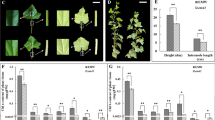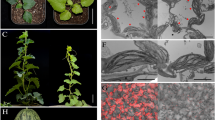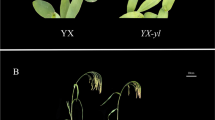Abstract
Key message
A yellow green peel mutant (ygp) in cucumber was caused by a mutation in Csa2G352940 encoding MYB36 transcription factor.
Abstract
Peel color is one of the important agronomic traits of cucumber (Cucumis sativus L.). However, studies on the molecular regulation mechanism of peel color in cucumber are few. In this study, a cucumber yellow green peel mutant (ygp) of cucumber mutagenized with ethylmethylsulfone by using a wild type cucumber with dark green peel was identified. Pigment measurements indicated that the chlorophyll content of the ygp mutant was less than that of the wild type. Genetic analysis revealed that the phenotype of the ygp mutant was monogenic recessive inheritance. MutMap and genotyping results demonstrated that Csa2G352940 (CsMYB36), encoding the transcription factor MYB36, was the causal gene of the ygp mutant in cucumber. CsMYB36 was downregulated in the fruit of the ygp mutant. Transcriptome profile analysis of the fruit peel of the ygp mutant identified 92 candidate genes including genes that encode Casparian strip (CsCASP1) and pigment synthesis protein (CsMYC2) involved in peel color development in cucumber. CsMYB36 may regulate yellow green coloration in cucumber by interacting with these genes. Overall, these results showed that CsMYB36 can regulate the yellow green peel coloration in cucumber.





Similar content being viewed by others
References
Abdel-Aal ESM, Hucl P (2003) Composition and stability of anthocyanins in blue-grained wheat. J Agric food Chem 8:2174–2180
Abe A, Kosugi S, Yoshida K, Natsume S, Takagi H, Kanzaki H et al (2012) Genome sequencing reveals agronomically important loci in rice using MutMap. Nat Biotechnol 30:174–178
Arnon DI (1949) Copper enzymes in isolated chloroplasts, polyphenoloxidase in Beta vulgaris. Plant Physiol 24:1–15
Ballester A, Molthoff J, Vos R, Hekkert B, Orzaez D, Moreno J et al (2010) Biochemical and molecular analysis of pink tomatoes: deregulated expression of the gene encoding transcription factor SlMYB12 leads to pink tomato fruit color. Plant Physiol 152:71–84
Baudry A, Caboche M, Lepiniec L (2006) TT8 controls its own expression in a feedback regulation involving TTG1 and homologous MYB and bHLH factors, allowing a strong and cell-specific accumulation of flavonoids in Arabidopsis thaliana. Plant J 46:768–779
Beale SI (2005) Green genes gleaned. Trend Plant Sci J 10(7):309–312
Brand A, Borovsky Y, Hill T, Afnan K, Rahman A, Bellalou A et al (2014) CaGLK2 regulates natural variation of chlorophyll content and fruit color in pepper fruit. Theor Appl Genet 127:2139–2148
Chen C, Liu M, Jiang L, Liu X, Zhao J, Yan S et al (2014) Transcriptome profiling reveals roles of meristem regulators and polarity genes during fruit trichome development in cucumber (Cucumis sativus L.). J Exp Bot 65:4943–4958
Clark M (1997) Plant molecular biology: a laboratory manual. Springer, Berlin
Cocaliadis M, Muñoz R, Pons C, Orzaez D, Granell A (2014) Increasing tomato fruit quality by enhancing fruit chloroplast function. A double-edged sword? J Exp Bot 65:4589–4598
Dombrecht B, Xue G, Sprague S, Kirkegaard J, Ross J, Reid J et al (2007) MYC2 differentially modulates diverse jasmonate-dependent functions in Arabidopsis. Plant Cell 19:2225–2245
Fernandez-Moreno J, Tzfadia O, Forment J, Presa S, Rogachev I, Meir S et al (2016) Characterization of a new pink-fruited tomato mutant results in the identification of a null allele of the SlMYB12 transcription factor. Plant Physiol 171(3):1821–1836
Forth D, Pyke KA (2006) The suffulta mutation in tomato reveals a novel method of plastid replication during fruit ripening. J Exp Bot 57:1971–1979
Furukawa T, Maekawa M, Oki T, Suda I, Iida S, Shimada H et al (2006) The Rc and Rd genes are involved in proanthocyanidin synthesis in rice pericarp. Plant J 49(1):91–102
Gao ML, Hu LL, Li YH, Weng YQ (2016) The chlorophyll-deficient golden leaf mutation in cucumber is due to a single nucleotide substitution in CsChlI for magnesium chelatase I subunit. Theor Appl Genet 129:1961–1973
Gu X, Foley M, Horvath D, Anderson J, Feng J, Zhang L et al (2011) Association between seed dormancy and pericarp color is controlled by a pleiotropic gene that regulates abscisic acid and flavonoid synthesis in weedy red rice. Genet 189:1515–1524
Himi E, Maekawa M, Matsuura T, Taketa S (2015) Real-time PCR-mediated diagnosis of hemizygosity at the Tamyb10-D1 locus controlling grain color in wheat. Mol Breed 35:90
Huang S, Li R, Zhang Z, Li L, Gu X, Fan W et al (2009) The genome of the cucumber, Cucumis sativus L. Nat Genet 41:1275–1281
Hwang I, Kim Y, Han J, Nou S (2016) Orange color is associated with CYC-B expression in tomato fleshy fruit. Mol Breed 36:42
Kamiya T, Borghi M, Wang P, Danku J, Kalmbach L, Hosmania P et al (2015) The MYB36 transcription factor orchestrates Casparian strip formation. Proc Nat Acad Sci USA 33:10533–10538
Kim D, Langmead B, Salzberg SL (2015) HISAT: a fast spliced aligner with low memory requirements. Nat method 4:357
Kumpatla SP, Abdurakhmonov IY, Mammadov JA (2012) Genomics-assisted plant breeding in the st century: technological advances and progress. INTECH Open Access Publisher, Den Haag
Li H, Durbin R (2009) Fast and accurate short read alignment with burrows wheeler transform. Bioinformatics 25:1754–1760
Li H, Handsaker B, Wysoker A, Fennell T, Ruan J, Homer N et al (2009) The sequence alignment/map format and SAM tools. Bioinformatics 25:2078–2079
Liberman LM, Sparks EE, Moreno-Risueno MA, Petricka JJ, Benfey PN (2015) MYB36 regulates the transition from proliferation to differentiation in the Arabidopsis root. Proc Natl Acad Sci USA 39:12099–12104
Liu H, Jiao J, Liang X, Liu J, Meng H, Chen S, Li Y, Cheng Z (2016) Map-based cloning, identification and characterization of the w gene controlling white immature fruit color in cucumber (Cucumis sativus L.). Theor Appl Genet 129:1247–1256
Livak KJ, Schmittgen TD (2001) Analysis of relative gene expression data using real-time quantitative PCR and the 2-ΔΔCt method. Methods 25:402–408
Lorenzo O, Chico JM, Sanchez-Serrano JJ, Solano R (2004) JASMONATE-INSENSITIVE1 encodes a MYC transcription factor essential to discriminate between different jasmonate-regulated defense responses in Arabidopsis. Plant Cell 16:1938–1950
Lun Y, Wang X, Zhang C, Yang L, Gao D, Chen H, Huang SA (2016) CsYcf54 variant conferring light green coloration in cucumber. Euphytica 208:509–517
McKenna A, Hanna M, Banks E, Sivachenko A, Cibulskis K, Kernytsky A et al (2010) The genome analysis toolkit: a MapReduce framework for analyzing next-generation DNA sequencing data. Genome Res 20:1297–1303
Miao H, Zhang SP, Wang M, Wang Y, Weng YQ, Gu XF (2016) Fine mapping of virescent leaf gene v-1 in cucumber (Cucumis sativus L.). Int J Mol Sci 17:1602
Mochizuki N, Tanaka R, Grimm B, Masuda T, Moulin M, Smith AG et al (2010) The cell biology of tetrapyrroles: a life and death struggle. Trends Plant Sci 15:488–948
Mortazavi A, Williams BA, McCue K, Schaeffer L, Wold B (2008) Mapping and quantifying mammalian transcriptomes by RNA-Seq. Nat Methods 5:621–628
Nagata N, Tanaka R, Satoh S, Tanaka A (2005) Identification of a vinyl reductase gene for chlorophyll synthesis in Arabidopsis thaliana and implications for the evolution of Prochlorococcus species. Plant Cell 17(1):233–240
Nesi N, Debeaujon I, Jond C, Pelletier G, Caboche M, Lepiniec L (2000) The TT8 gene encodes a basic helix-loop-helix domain protein required for expression of DFR and BAN genes in Arabidopsis siliques. Plant Cell 12:1863–1878
Nguyen C, Vrebalov J, Gapper N, Zheng Y, Zhong S, Zhang J, Giovannoni J (2014) Tomato GOLDEN2-LIKE transcription factors reveal molecular gradients that function during fruit development and ripening. Plant Cell 26:585–601
Ni FR, Wu L, Wang Q, Hong J, Qi YJ, Zhou XP (2017) Turnip yellow mosaic virus P69 interacts with and suppresses GLK transcription factors to cause pale-green symptom in Arabidopsis. Mol Plant 10:764–766
Payne CT, Zhang F, Lloyd AM (2000) GL3 encodes a bHLH protein that regulates trichome development in arabidopsis through interaction with GL1 and TTG1. Genet 156:1349–1362
Pertea M, Pertea GM, Antonescu CM, Chang TC, Mendell JT, Salzberg SL (2015) StringTie enables improved reconstruction of a transcriptome from RNA-seq reads. Nat Bio 33:290–295
Pierce LK, Wehner TC (1990) Review of genes and linkage groups in cucumber. Hort Sci 25:605–615
Qi T, Huang H, Wu D, Yan J, Qi Y, Song S, Xie D (2014) Arabidopsis DELLA and JAZ proteins bind the WD-Repeat/bHLH/MYB complex to modulate gibberellin and jasmonate signaling synergy. Plant Cell 26:1118–1133
Rasheed A, He Z, Gao F, Zhai SN, Jin H, Liu JD et al (2016) Development and validation of KASP assays for genes underpinning key economic traits in bread wheat. Theor Appl Genet 129:1843–1860
Romualdi C, Bortoluzzi S, Alessi F, Danieli GA (2003) IDEG6: a web tool for detection of differentially expressed genes in multiple tag sampling experiments. Physiol Genom 12:159–162
Schaart JG, Dubos C, Romero De La Fuente I, Van Houwelingen AM, De Vos RC, Jonker HH et al (2013) Identification and characterization of MYB-bHLH-WD40 regulatory complexes controlling proanthocyanidin biosynthesis in strawberry (Fragaria × ananassa) fruits. New Phytol 197:454–467
Stracke R, Werber M, Weisshaar B (2001) The R2R3-MYB gene family in Arabidopsis thaliana. Curr Opin Plant Biol 4:447–456
Thimm O, Bläsing O, Gibon Y, Nagel A, Meyer S, Krüger P et al (2004) MAPMAN: a user-driven tool to display genomics data sets onto diagrams of metabolic pathways and other biological processes. Plant J 37:914–939
Toledo-Ortiz G, Huq E, Quail PH (2003) The Arabidopsis basic/helix-loop-helix transcription factor family. Plant Cell 15:1749–1770
Walker AR, Davison PA, Bolognesi-Winfield AC, James CM, Srinivasan N, Blundell TL et al (1999) The TRANSPARENT TESTA GLABRA1 locus, which regulates trichome differentiation and anthocyanin biosynthesis in Arabidopsis, encodes a WD40 repeat protein. Plant Cell 11:1337–1350
Wang K, Li M, Hakonarson H (2010) ANNOVAR: functional annotation of genetic variants from high-throughput sequencing data. Nucleic Acids Res 38:e164
Xie J, Wehner TC (2001) Gene list 2001 for cucumber. Cucurbit Genet Coop Report 24:110–136
Xu W, Grain D, Bobet S, Le Gourrierec J, Thevenin J, Kelemen Z et al (2014) Complexity and robustness of the flavonoid transcriptional regulatory network revealed by comprehensive analyses of MYB-bHLH-WDR complexes and their targets in Arabidopsis seed. New Phytol 202:132–144
Xu W, Dubos C, Lepiniec L (2015) Transcriptional control of flavonoid biosynthesis by MYB-bHLH-WDR complexes. Trends Plant Sci 20:176–185
Xue C, Wang C, Fan L, Hao N, Zou D, Zhang Q et al (2016) Ethylmethane sulfonate mutagenesis of cucumber for large-scale mutant screens. Pak J Bot 48:2261–2266
Yin YG, Kobayashi Y, Sanuki A, Kondo S, Fukuda N, Ezura H et al (2010) Salinity induces carbohydrate accumulation and sugar-regulated starch biosynthetic genes in tomato (Solanum lycopersicum L. cv. ‘Micro-Tom’) fruits in an ABA and osmotic stress-independent manner. J Exp Bot 61:563–574
Yundaeng C, Somta P, Tangphatsornruang S, Chankaew S, Srinives P (2015) A single base substitution in BADH/AMADH is responsible for fragrance in cucumber (Cucumis sativus L.), and development of SNAP markers for the fragrance. Theor Appl Genet 128:1881–1892
Zhang F, Gonzalez A, Zhao M, Payne CT, Lloyd A (2003) A network of redundant bHLH proteins functions in all TTG1-dependent pathways of Arabidopsis. Development 130:4859–4869
Zhou Q, Wang S, Hu B, Chen H, Zhang Z, Huang S (2015) An ACCUMULATION AND REPLICATION OF CHLOROPLASTS 5 gene mutation confers light green peel in cucumber. J Integr Plant Biol 57:936–942
Funding
This work was supported by National Natural Science Foundation of China (Grant Number 31701934), University Nursing Program for Young Scholars with Creative Talents in Heilongjiang Province (Grant Number UNPYSCT-2015001), ‘Academic backbone’ Project of Northeast Agricultural University (Grant Number 16XG05), Key Laboratory of Biology and Genetic Improvement of Horticultural Crops (Northeast Region), Ministry of Agriculture/Northeast Agricultural University (Grant Number neauhc201601), Natural Science Foundation of Shanghai (Grant Number 15ZR1429800), and The Science and Technology Planning Project of Guangxi Province (Grant Number 1598006-3-2).
Author information
Authors and Affiliations
Corresponding author
Ethics declarations
Conflict of interest
The authors have no conflicts of interest to declare.
Additional information
Communicated by Sanwen Huang.
Electronic supplementary material
Below is the link to the electronic supplementary material.
Rights and permissions
About this article
Cite this article
Hao, N., Du, Y., Li, H. et al. CsMYB36 is involved in the formation of yellow green peel in cucumber (Cucumis sativus L.). Theor Appl Genet 131, 1659–1669 (2018). https://doi.org/10.1007/s00122-018-3105-7
Received:
Accepted:
Published:
Issue Date:
DOI: https://doi.org/10.1007/s00122-018-3105-7




